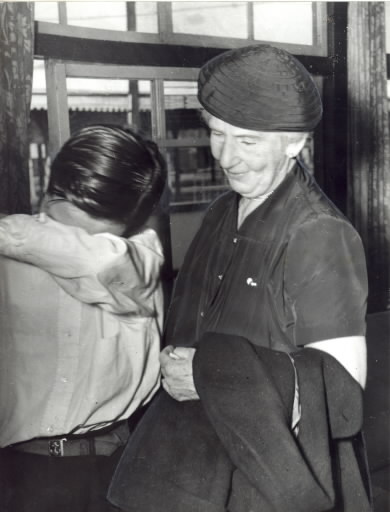The "Moral Adoption" of Hiroshima’s A-bomb Orphans, Part I [8]
Feb. 1, 2009
Lingering ties between moral parents and adopted children
by Akira Tashiro and Masami Nishimoto, Staff Reporters
In the mid-1950s, the moral adoption campaign suddenly waned. In 1960, the Hiroshima Municipal War Orphans Foster Home changed its name to the Municipal Children’s Home. The number of children from impoverished families came to exceed that of A-bomb orphans at the home. The number of adopted children, who had already left the facility, decreased to only six. A thank-you note to a moral mother for a Christmas gift conveys the lives of these adopted children, now grown:
“Those who have left the home have a reunion once a year on January 2. But people who moved to distant prefectures rarely come. Maybe it’s not so easy to come because of their work or families. Though I live near the foster home, it’s not easy for me to visit the home.” [By a salesperson, on January 15, 1960]
The money for supporting the children, which was collected by the U.S. Hiroshima Peace Center Association, a contact point for the moral adoption campaign in the United States, tended to be left unpaid. In 1961, there were 124 moral parents in total. As the adopted children grew, the moral parents became less interested in the campaign. In April 1959, the association announced its intention to stop sending the donations. The moral adoption campaign, which had begun in 1950, was virtually over.
“Dear Aunt, I can live a college life today, because you continuously encouraged me from beyond the sea during the depressing days on my sickbed. I can’t say how much I was encouraged by you. I’m engaged in a fundraising campaign at college, visiting remote areas and investigating slums. My life has grown to be exciting. I’m feeling happy to be alive.” [By a college freshman, on September 1, 1959]
The writer of this letter finally found the opportunity to go to college after a battle with tuberculosis that lasted two-and-a-half years. Like this young man who shared his joy with his moral mother, children at the Hiroshima War Orphans Foster Home, with the support of the people around them, overcame their fate as A-bomb orphans and created independent lives.
At the same time, there were a few moral parents and adopted children who formed a deeper human bond beyond that of “moral parent” and “adopted child.”
At the news of the death of his moral father, who was a priest, a young man wrote a long letter in English in his own hand and offered the letter to his moral father’s soul. This letter, headed “With gratitude and hope,” was included in a booklet issued by the church. Since that time, the man has carefully kept the booklet and a book written by the priest. The book, a memento from his moral father, is entitled I Believe in Humans.
“With gratitude and hope”
“Due to the war, we lost things both physically and spiritually. Having faced with the dark side of people’s mind, I encountered my moral father. He attentively watched me grow up and taught me humanitarianism. My joy and sorrow to date is enshrined in the long correspondence with my moral father.
“My sorrow caused by the atomic bomb has melted away thanks to the warm hearts of people. I have no intention to take revenge for what happened in the past. I can understand your campaigns for Hiroshima as well as the American crew members arguing that they have no regrets about dropping the atomic bomb. But I wonder why my childhood, which was supposed to be the happiest period spent with my parents, had to be ruined.
“The creation of a path toward the world peace totally depends on our actions from now on. I sincerely hope to make beautiful flowers bloom out of the ruins. My story is not to make you shed tears, but to ask you for courage to establish peace.” [October 1961]
Keywords
U.S. Hiroshima Peace Center Association
The U.S. Hiroshima Peace Center Association was founded in 1949 and helped support the medical treatment of the so-called “Hiroshima Maidens” in the United States. For the moral adoption program, the organization served as intermediary between the American moral parents and their Japanese adopted children, collecting and transferring financial support. After this form of support was discontinued, they established a scholarship fund for education. In 1960-61, financial assistance was made available for some of the grown children to attend college.
(Originally published on July 21, 1988)








